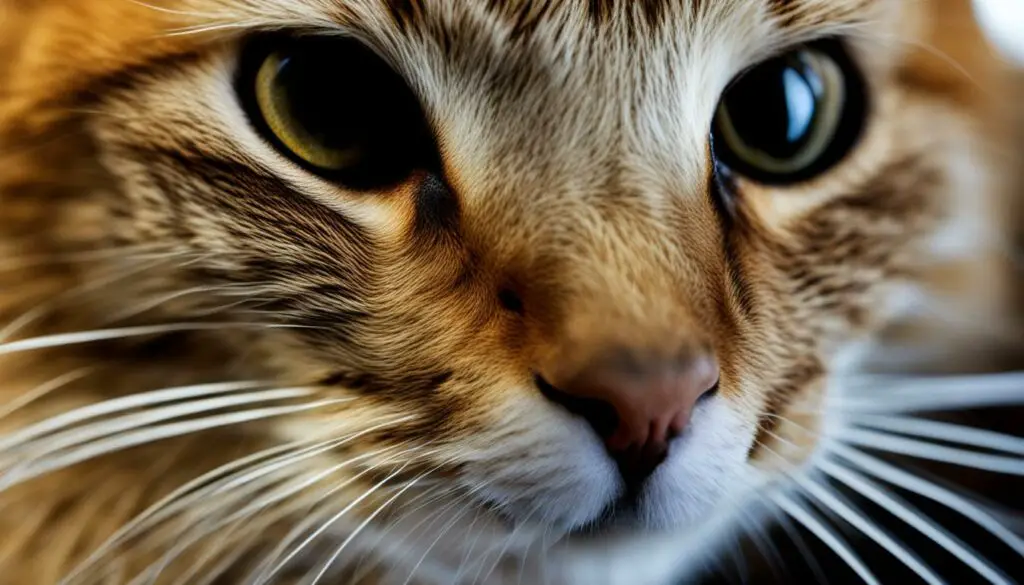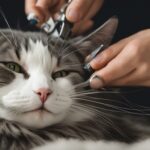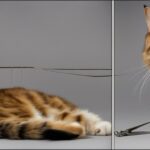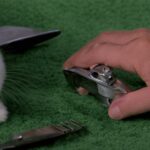Accidentally cutting a cat’s whiskers can have unintended consequences that can impact their well-being. Cat whiskers, also known as vibrissae, are far more than just facial hairs. They play a crucial role in a cat’s life, helping them navigate their environment, detect changes in their surroundings, and accurately locate prey. Understanding the purpose and anatomy of cat whiskers is essential before delving into the potential consequences of accidentally cutting them.
Key Takeaways:
- Accidentally cutting a cat’s whiskers can disrupt their ability to navigate and estimate their surroundings.
- Whiskers serve as sensory organs that allow cats to detect changes in their environment and estimate the size, texture, and distance of objects.
- Cat whiskers have a unique structure, consisting of three layers and containing numerous nerve endings and blood vessels.
- The growth cycle of cat whiskers involves regrowth, but it can take several months for them to fully grow back.
- Cutting a cat’s whiskers can impair their balance, increase their stress and anxiety, and limit their communication and socialization abilities.
Understanding Cat Whiskers
Cat whiskers, also known as vibrissae, are fascinating sensory organs that play a crucial role in a cat’s life. These long, thick, and flexible hairs are deeply rooted in a cat’s face, legs, and above their eyes. They have a rich supply of nerves and blood vessels, making them highly sensitive. Whiskers serve as sensory organs that allow cats to navigate their environment, detect changes in their surroundings, and estimate the size, texture, and distance of objects.
Whiskers are not just ordinary hairs. They have a unique structure that sets them apart. Each whisker consists of three layers: the medulla, cortex, and cuticle. The medulla is the innermost layer responsible for the whisker’s structure, while the cortex gives the whisker its color and strength. The cuticle acts as a protective layer. These layers, along with numerous nerve endings and blood vessels, make whiskers highly sensitive and essential for a cat’s well-being.
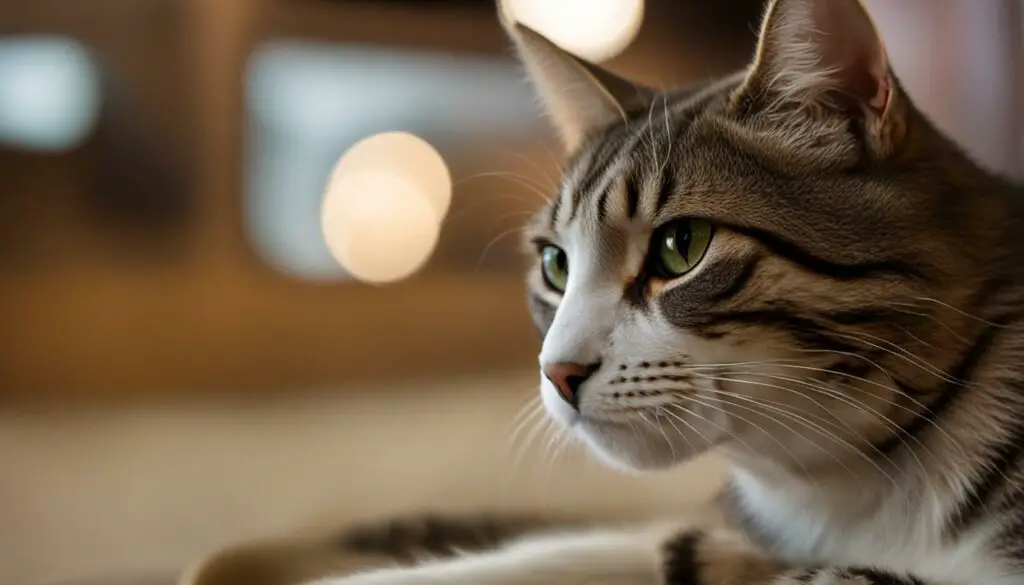
Accidentally cutting a cat’s whiskers can have significant consequences. Whiskers help cats navigate their environment by sending messages to the brain whenever they come into contact with an object. These messages enable cats to understand the size, texture, and distance of the object, ensuring they can safely navigate their surroundings and hunt prey with accuracy. When the whiskers are cut, a cat’s ability to navigate and estimate their surroundings becomes disrupted, leading to potential consequences.
To understand the impact of cutting cat whiskers, it’s crucial to recognize their importance and functions. Cats rely on their whiskers for balance, coordination, and communication. Cutting or trimming a cat’s whiskers should be avoided whenever possible to ensure their overall health and well-being.
Key takeaways:
- Cat whiskers, also known as vibrissae, are long, thick, and deeply rooted hairs that act as sensory organs for cats.
- Whiskers allow cats to navigate their environment, detect changes, and estimate object size, texture, and distance.
- Accidentally cutting a cat’s whiskers can disrupt their ability to navigate and estimate their surroundings.
- Whiskers have a unique structure and are highly sensitive due to multiple layers, nerve endings, and blood vessels.
- Cutting cat whiskers should be avoided to ensure a cat’s overall health and well-being.
Table: Cat Whiskers Structure
| Layer | Description |
|---|---|
| Medulla | Innermost layer responsible for whisker structure |
| Cortex | Gives whisker color and strength |
| Cuticle | Protective outer layer |
Understanding cat whiskers and their importance can help us appreciate their role in a cat’s life. Their unique structure and sensitivity make them vital sensory organs that should be treated with care and respect.
The Purpose of Whiskers
Whiskers are not just cute adornments on a cat’s face; they serve a vital purpose in their everyday lives. Accidentally cutting a cat’s whiskers can have consequences that impact their ability to navigate and interact with their environment. Let’s explore the importance of whiskers and the potential effects of cutting them.
Whiskers act as sensory organs that provide cats with essential information about their surroundings. When a cat’s whiskers come into contact with an object, they send messages to the brain, allowing the cat to determine the size, texture, and distance of the object. This information enables cats to safely maneuver through tight spaces, judge whether they can fit through an opening, and accurately hunt their prey. Accidentally cutting a cat’s whiskers disrupts this communication system, potentially leading to disorientation and difficulty in navigating their surroundings.
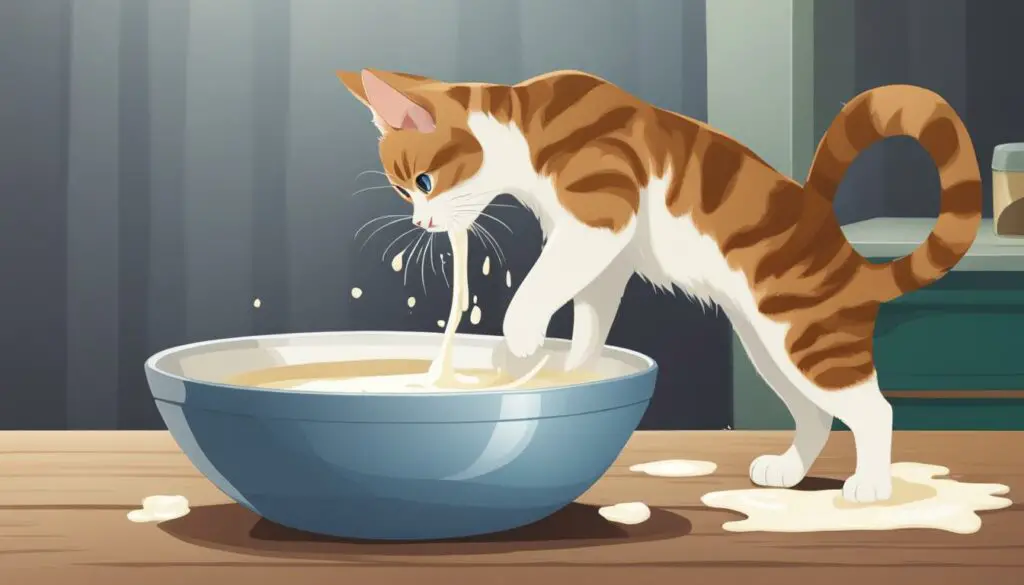
Table: Potential Consequences of Cutting Cat Whiskers
| Consequence | Description |
|---|---|
| Disorientation | Without their whiskers, cats may struggle to accurately gauge the size and layout of their environment, which can lead to confusion and disorientation. |
| Difficulty in Navigation | Whiskers help cats navigate through tight spaces and judge whether they can fit, cutting them can make it harder for cats to move around comfortably. |
| Increased Stress and Anxiety | Accidental cutting of whiskers can cause stress and anxiety in cats as they lose a crucial sensory tool, affecting their overall well-being. |
| Risk of Injury | Without their whiskers’ ability to accurately determine distances, cats may be more prone to accidents or injuries while navigating or hunting. |
| Communication and Socialization Limitations | Cats use their whiskers to communicate with other cats, cutting them can limit their ability to express themselves and may affect their social interactions. |
Understanding the purpose and importance of whiskers emphasizes the need to handle them with care and avoid accidental trimming. Cats rely on their whiskers for their day-to-day activities, and preserving their natural sensory abilities ensures their overall well-being. If you accidentally cut your cat’s whiskers, monitor their behavior for any signs of distress and provide a comfortable environment to help them adjust during the regrowth process.
The Anatomy of Cat Whiskers
Understanding the anatomy of cat whiskers is vital to grasp their importance in a feline’s life. Cat whiskers consist of three layers: the medulla, cortex, and cuticle. The medulla, the innermost layer, provides structure to the whisker, while the cortex gives it color and strength. The cuticle acts as a protective layer, shielding the whisker from damage. Each whisker is deeply rooted in the skin and contains numerous nerve endings and blood vessels, making it highly sensitive.
Just like any other part of a cat’s body, cat whiskers go through a natural growth cycle. It takes time for a whisker to reach its full length, which can be up to two months. When a whisker falls out, a new one grows in its place, slightly thicker and longer than before. This growth process is not random; whiskers follow a specific pattern that helps cats sense their environment better.
| Layer | Description |
|---|---|
| Medulla | The innermost layer responsible for structure |
| Cortex | Gives color and strength to the whisker |
| Cuticle | Acts as a protective layer |
The unique structure of cat whiskers and their sensitivity play a crucial role in a cat’s life. They help cats navigate their surroundings, detect changes, estimate distances, and even hunt prey with accuracy. Cutting a cat’s whiskers can disrupt these essential functions and have significant consequences for their overall well-being. It is essential to recognize and respect the importance of cat whiskers to ensure the best possible quality of life for our feline companions.
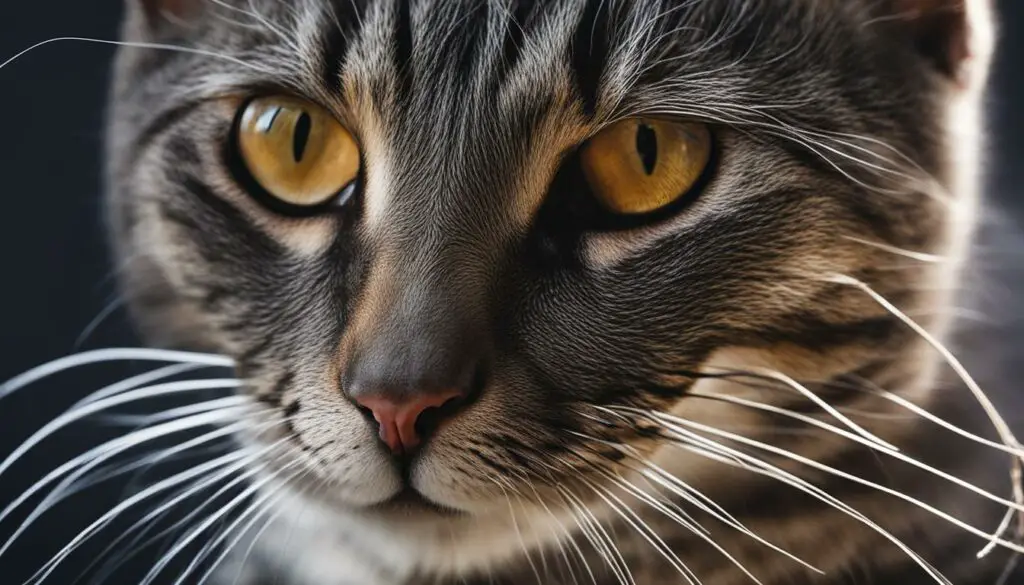
Quote:
“Understanding the structure and purpose of cat whiskers is vital for cat owners to appreciate their significance. The unique anatomy, including the medulla, cortex, and cuticle, along with the rich nerve endings and blood vessels, makes whiskers highly sensitive sensory organs. Cutting a cat’s whiskers can have detrimental effects on their ability to navigate and understand their surroundings, impacting their overall well-being.”
Whisker Growth Cycle
After accidentally cutting a cat’s whiskers, many owners wonder if they will grow back. The good news is that cat whiskers do have the ability to regrow, although the process can be slow. It can take up to two months for a cat’s whisker to grow to its full length. During this time, it’s important to provide a safe and comfortable environment for your cat to aid in the regrowth process.
Cat whiskers go through a growth cycle similar to regular hairs. They grow, fall out, and regrow, but at a slower rate. When a whisker falls out, it is replaced by a new one that is slightly thicker and longer. The growth of whiskers is not random and follows a specific pattern that helps cats sense their environment better.
Whisker Growth Pattern
| Growth Stage | Description |
|---|---|
| Anagen | The active growth phase where the whisker is fully formed and rooted in the skin. |
| Catagen | The transitional phase where the whisker stops growing but remains in place. |
| Telogen | The resting phase where the whisker falls out and is replaced by a new one. |
During the anagen phase, the whisker is fully formed and actively growing. It is deeply rooted in the skin, allowing it to receive the necessary nutrients for growth. In the catagen phase, the whisker stops growing but remains in place. Finally, during the telogen phase, the old whisker falls out, making way for a new one to take its place. This cycle ensures that cats always have a full set of functional whiskers.
It’s important to note that while the whiskers are regrowing, they may be more sensitive than usual. Avoid touching or trimming them during this time to prevent any discomfort for your cat. With patience and care, your cat’s whiskers will gradually regain their full length, allowing them to navigate and sense their surroundings effectively once again.
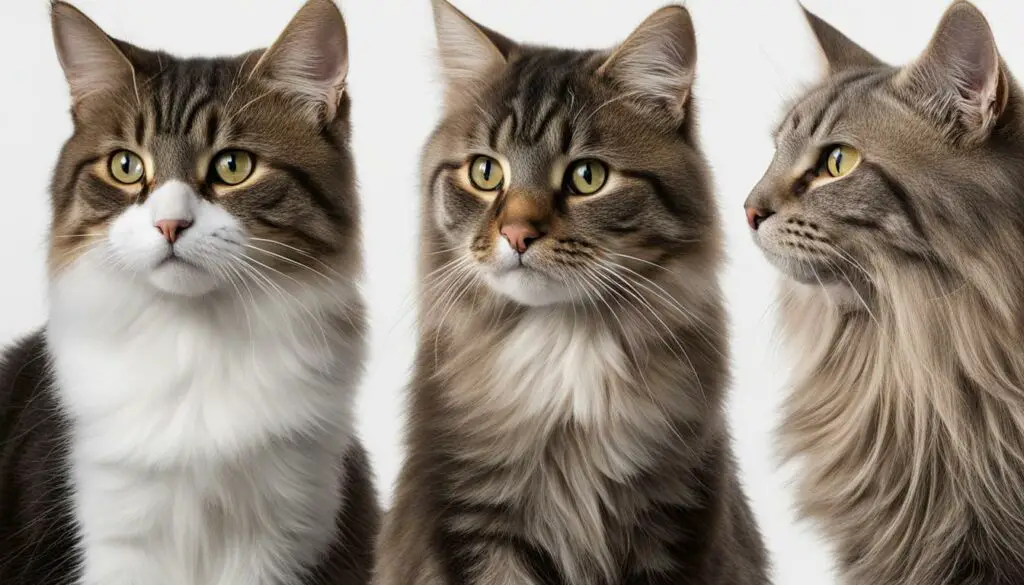
Reasons Why Whiskers Might Be Cut or Damaged
Accidentally cutting a cat’s whiskers can happen more often than we think. Cats are curious creatures and can brush against sharp objects, resulting in the accidental trimming of their whiskers. Additionally, well-meaning owners may unintentionally cut their cat’s whiskers while trying to groom them. It’s important to be cautious and take preventive measures to avoid cutting a cat’s whiskers and ensure their well-being.
One way to prevent cutting cat whiskers is to be mindful of the objects and surfaces in a cat’s environment. Keep sharp objects out of their reach and avoid placing them in areas where a cat commonly explores. When grooming your cat, be gentle and use only cat-specific grooming tools to minimize the risk of accidentally trimming their whiskers.
Another reason why a cat’s whiskers might be cut is due to underlying health issues. Conditions such as cancer or fungal infections can cause damage to the whiskers, leading to partial or complete loss. If you notice any changes in your cat’s whiskers, such as bald patches or irregular growth, it’s essential to consult with a veterinarian for proper diagnosis and treatment.
Ways to Prevent Cutting Cat Whiskers:
- Keep sharp objects out of a cat’s reach
- Be mindful when grooming your cat
- Use cat-specific grooming tools
- Regularly inspect your cat’s whiskers for any abnormalities
- Consult a veterinarian if you notice changes in your cat’s whiskers
Table: Common Causes of Accidental Whisker Cutting
| Cause | Description |
|---|---|
| Curiosity | Cats are naturally curious and may brush against sharp objects, resulting in the accidental trimming of their whiskers. |
| Owner Grooming | Well-meaning owners may unintentionally cut their cat’s whiskers while grooming them, especially if they are not using cat-specific grooming tools. |
| Health Issues | Underlying conditions such as cancer or fungal infections can cause damage to a cat’s whiskers, leading to partial or complete loss. |
“Accidental cutting of a cat’s whiskers can disrupt their ability to navigate and estimate their surroundings, leading to potential consequences.”
By taking precautionary measures and being mindful of a cat’s surroundings, we can prevent the accidental cutting of their whiskers and ensure their health and well-being. Regularly inspect your cat’s whiskers for any abnormalities and consult a veterinarian if you notice any changes. Let’s prioritize the natural functions and sensory abilities of a cat’s whiskers to provide them with a safe and comfortable environment.
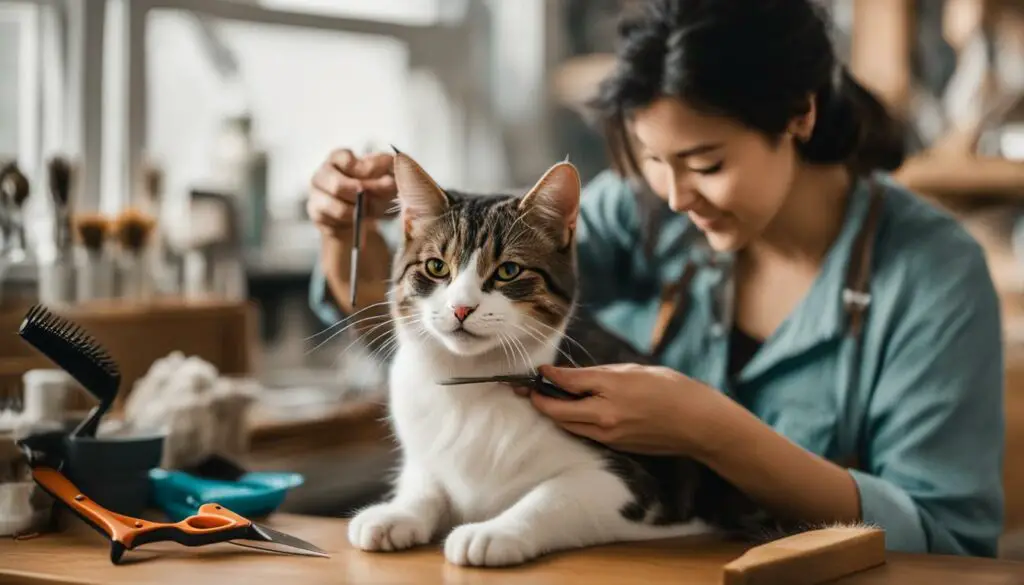
The Regrowth Process of Cat Whiskers
If you accidentally trim your cat’s whiskers, don’t panic. Cat whiskers can grow back, although the process may take some time. Factors such as the cat’s age, health, and diet can affect the regrowth rate, so it’s important to provide the right conditions for whisker restoration.
A balanced diet plays a crucial role in promoting healthy whisker regrowth. Make sure your cat’s diet is rich in essential nutrients like protein, vitamins, and minerals. Consult with your veterinarian to ensure you’re providing the right nutrition for your cat’s specific needs.
In addition to a proper diet, a stress-free environment can also contribute to the regrowth process. Cats are sensitive creatures, and stress can impede their overall well-being. Provide a calm and comfortable space for your cat, with access to hiding spots and familiar objects. Minimize any potential triggers of anxiety or stress.
| Factors Affecting Whisker Regrowth | Impact on Regrowth Process |
|---|---|
| Age | Elderly cats may experience slower regrowth compared to younger cats. |
| Health | Cats with underlying health issues may have a delayed regrowth process. |
| Diet | A nutrient-rich diet promotes faster and healthier regrowth. |
| Stress | A stress-free environment facilitates the regrowth process. |
During the regrowth process, monitor your cat’s behavior for any signs of distress or discomfort. If you notice any unusual symptoms or if concerns persist, it’s best to consult with your veterinarian for further guidance. They can assess your cat’s specific situation and provide tailored advice to ensure a smooth regrowth process.
Remember, patience is key when it comes to whisker regrowth. With the right care, your cat’s whiskers will eventually grow back, restoring their natural sensory abilities and overall well-being.

Potential Consequences of Cutting Cat Whiskers
Accidentally cutting a cat’s whiskers can have several potential consequences that can greatly impact their overall well-being and quality of life. These consequences range from impairing their balance and navigation abilities to affecting their behavior and socialization skills.
One of the main consequences of cutting a cat’s whiskers is that it can impair their balance and coordination. Whiskers play a crucial role in helping cats gauge their surroundings, navigate tight spaces, and maintain their stability. Without their whiskers, cats may experience disorientation and difficulty in moving around, increasing the risk of accidents and injuries.
Cutting cat whiskers can also lead to increased stress and anxiety in cats. Whiskers serve as a source of sensory information, allowing cats to assess their environment and feel secure. When their whiskers are cut, cats may become more anxious and fearful, as their ability to accurately gauge their surroundings is compromised.
Furthermore, cutting cat whiskers can impact a cat’s behavior and communication abilities. Whiskers play a significant role in a cat’s social interactions and communication with other cats and humans. Cats use their whiskers to convey their emotions and intentions, and without them, they may struggle to express themselves effectively.
Accidentally cutting a cat’s whiskers can disrupt their ability to navigate and estimate their surroundings, leading to potential consequences.
In conclusion, cutting a cat’s whiskers can have significant consequences on their well-being, including impaired balance and navigation abilities, increased stress and anxiety, and limitations in behavior and communication. It is crucial to understand the importance and functions of cat whiskers and prioritize their preservation to ensure a cat’s overall health and happiness.
| Consequences of Cutting Cat Whiskers | Description |
|---|---|
| Impaired balance and navigation | Without whiskers, cats may struggle to gauge their surroundings, leading to disorientation and difficulty in moving. |
| Increased stress and anxiety | Whiskers provide cats with sensory information, and cutting them can cause heightened anxiety and fear. |
| Impact on behavior and communication | Cat whiskers play a significant role in a cat’s social interactions and communication with others, and cutting them can limit these abilities. |
Why You Should Not Cut A Cat’s Whiskers
Trimming a cat’s whiskers may seem harmless, but it can have serious consequences for their sensory abilities and overall well-being. Cat whiskers are not just ordinary hairs; they serve important functions that are essential for a cat’s survival and happiness. Cutting a cat’s whiskers can cause sensory deprivation, leading to disorientation, difficulty in navigation, and increased stress and anxiety. It is crucial to avoid cutting cat whiskers to ensure their overall health and well-being.
Cat whiskers play a vital role in helping cats navigate their surroundings. They provide essential sensory information about their environment, allowing cats to assess the size, texture, and distance of objects. Whiskers also help cats determine if they can safely maneuver through tight spaces or hunt prey with accuracy. By cutting a cat’s whiskers, you disrupt their natural abilities, making it harder for them to move around and adapt to their surroundings.
Furthermore, cutting a cat’s whiskers can increase their stress levels and anxiety. Whiskers not only serve as sensory organs but also play a role in communication and socialization. Cats use their whiskers to gauge the distance between themselves and other objects or animals, including fellow cats. When their whiskers are cut, cats may struggle to communicate effectively, leading to frustration and potentially affecting their behavior.
In addition to the psychological impact, cutting a cat’s whiskers can also put them at a higher risk of injury. Whiskers serve as a built-in safety mechanism, allowing cats to sense their surroundings and avoid potential dangers. Without their whiskers, cats may misjudge distances or fail to detect obstacles, increasing the likelihood of accidents and injuries.
| Consequences of Cutting Cat Whiskers |
|---|
| Disorientation and difficulty in navigation |
| Increased stress and anxiety |
| Limitations in communication and socialization |
| Higher risk of accidents and injuries |
It is essential to prioritize your cat’s well-being and avoid unnecessary cutting or trimming of their whiskers. While there may be rare circumstances where trimming is necessary for medical reasons or specific grooming requirements, such actions should always be undertaken under the guidance of a veterinarian or professional groomer. By respecting and preserving a cat’s whiskers, you ensure that they can live a happy and fulfilling life, relying on their natural instincts and abilities.
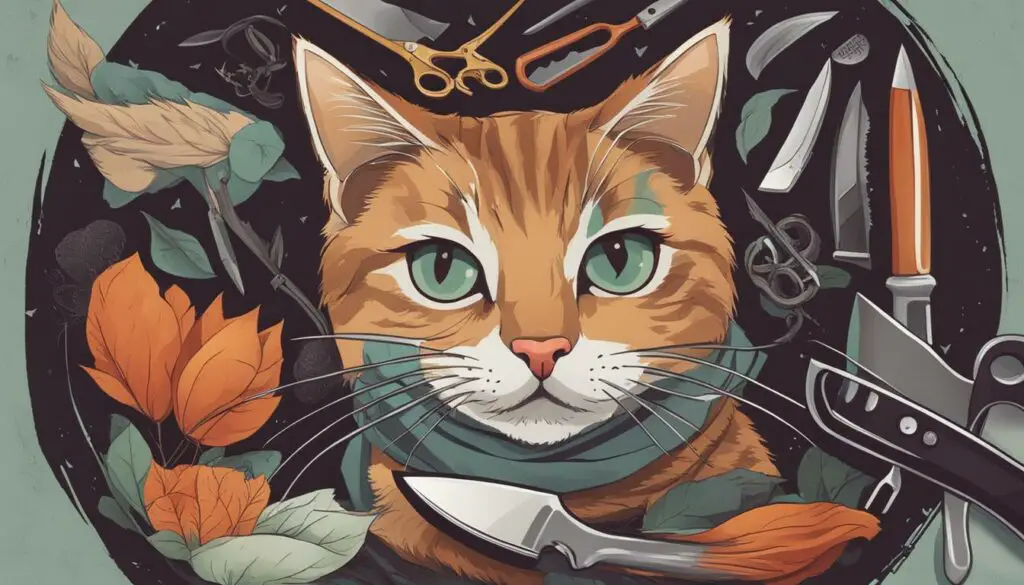
What Happens If You Cut A Cat’s Whiskers
If you accidentally cut a cat’s whiskers, it can have significant consequences for their sensory abilities and overall well-being. Whiskers play a crucial role in helping cats navigate their environment and detect changes in their surroundings. When these important sensory organs are cut, it disrupts a cat’s natural abilities and can lead to disorientation and difficulty in navigating their surroundings. Cats may become stressed, anxious, and more prone to accidents or injuries.
Trimming a cat’s whiskers should only be done in rare cases and under the guidance of a veterinarian or professional groomer. It’s important to prioritize a cat’s well-being and avoid unnecessary cutting or trimming of their whiskers. While the whiskers will eventually grow back, it may take time for them to fully regrow. During the healing process, it’s crucial to provide a comfortable and stress-free environment for the cat.
Remember: Cutting a cat’s whiskers disrupts their natural sensory abilities, impairing their balance, navigation, and communication abilities. Avoiding whisker cutting accidents is essential for ensuring a cat’s overall health and happiness.
Table: Potential Consequences of Cutting Cat Whiskers
| Consequence | Description |
|---|---|
| Disorientation | Cutting a cat’s whiskers can lead to disorientation and difficulty in navigating their surroundings. |
| Injury | Decreased ability to gauge surroundings can increase the risk of accidents and injuries. |
| Stress and Anxiety | Disrupted sensory abilities can lead to increased stress and anxiety in cats. |
| Impaired Communication | Cutting whiskers limits a cat’s ability to communicate and socialize effectively. |
Accidental cutting or trimming of a cat’s whiskers should be avoided at all costs. By prioritizing the health and natural functions of a cat’s whiskers, we can ensure their overall well-being and provide them with the best possible quality of life.
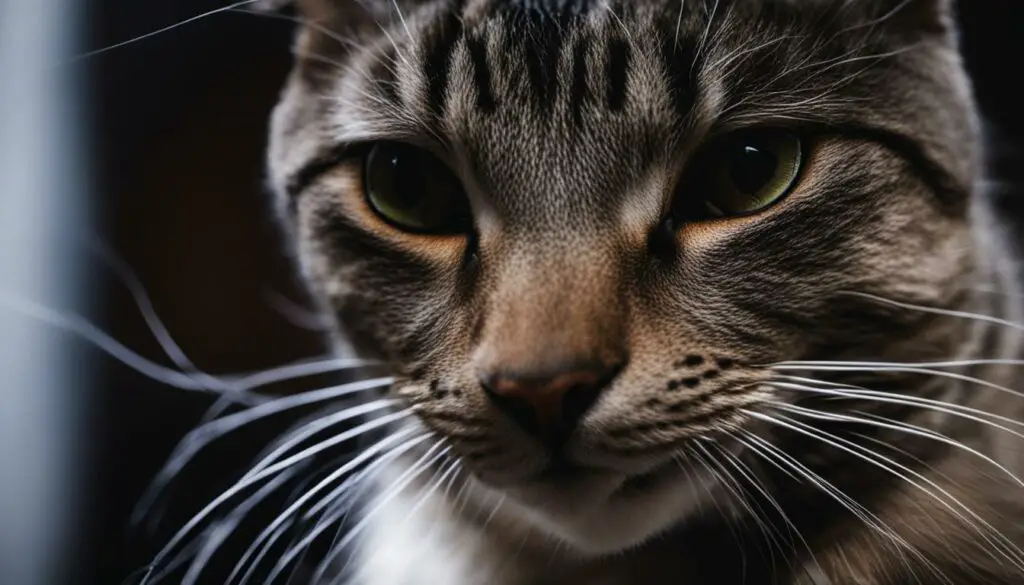
Are There Any Situations In Which It May Be Necessary To Trim A Cat’s Whiskers?
While it is generally advised not to trim a cat’s whiskers due to their important sensory functions, there are limited situations where trimming may be necessary. These situations include vet-approved medical procedures or specific grooming requirements for cat shows. However, it is crucial to approach whisker trimming as a last resort and under professional supervision to minimize any negative consequences for the cat’s well-being.
Trimming a cat’s whiskers may be necessary in certain medical procedures, such as surgeries or treatments. Veterinarians may choose to temporarily trim the whiskers to ensure better access to the affected area. However, this should only be done when deemed absolutely necessary and in consultation with a qualified veterinarian.
In rare cases, certain cat shows may have grooming requirements that necessitate a temporary trimming of whiskers. However, even in such cases, it is important to prioritize the cat’s well-being and ensure that the trimming is done safely and with minimal impact on the cat’s sensory abilities.
Overall, it is essential to remember that cat whiskers serve vital functions for a cat’s survival and well-being. Therefore, any decision to trim or cut a cat’s whiskers should be made with utmost caution and professional guidance to preserve the natural functions and sensory abilities of these remarkable sensory organs.
What To Do If You Accidentally Trim Your Cat’s Whiskers
If you find yourself in the unfortunate situation of accidentally trimming your cat’s whiskers, it’s essential to take the appropriate steps to ensure their healing and well-being. Although the whiskers will eventually grow back, it may take time, and your cat may experience some discomfort or distress. Here are some guidelines to follow:
- Monitor your cat’s behavior: Keep a close eye on your cat for any signs of distress or discomfort. Look out for changes in their mood, appetite, or overall behavior. If you notice any concerning symptoms, it’s best to consult with a veterinarian for further guidance.
- Provide a comfortable environment: Create a safe and stress-free space for your cat to recover. Ensure they have a cozy bed, fresh water, and access to their litter box. Minimize loud noises and other potential stressors that may worsen their discomfort.
- Be patient and consistent: Whiskers take time to grow back fully, so it’s important to be patient during the healing process. Provide your cat with consistent love, care, and attention to help them adjust. Offer gentle reassurance and avoid any actions that may cause further distress.
“If you accidentally trim your cat’s whiskers and notice signs of distress or discomfort, it’s important to monitor their behavior and provide a comfortable and stress-free environment.”
Remember, cats rely on their whiskers for balance, navigation, and sensing their surroundings. While accidents happen, it’s crucial to take precautions to prevent future incidents and prioritize your cat’s well-being. Avoid cutting or trimming their whiskers unless it’s necessary for medical or grooming purposes and always consult with professionals for guidance. By providing the right care and attention, you can ensure your cat’s whiskers grow back healthily, and their sensory abilities are restored.
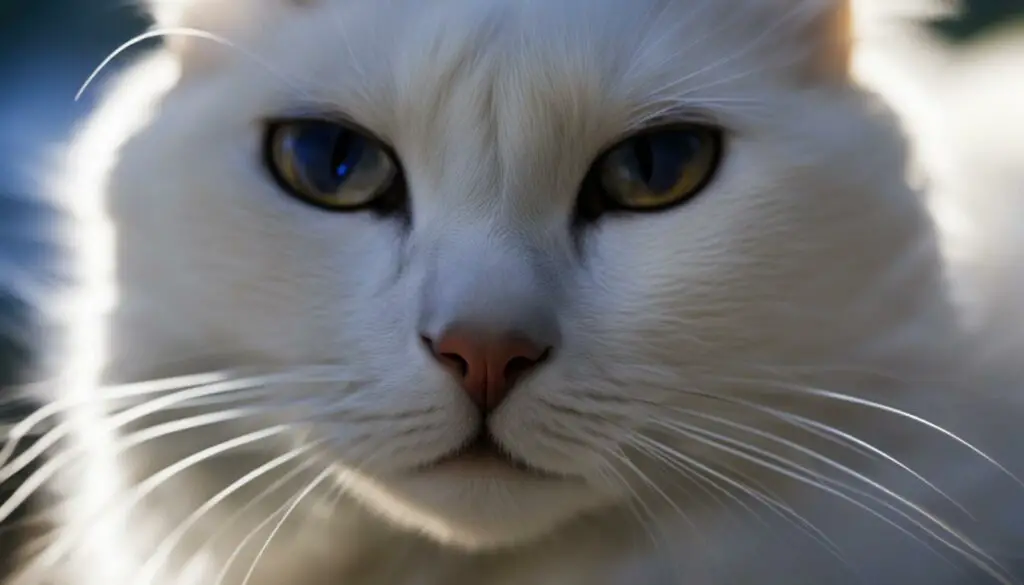
Conclusion
Accidentally cutting a cat’s whiskers can have significant consequences for their sensory abilities and overall well-being. Understanding the importance and functions of cat whiskers is crucial to prevent accidents and prioritize their health. It is essential to avoid cutting or trimming a cat’s whiskers unless necessary for medical or grooming reasons, and to always prioritize the natural functions of whiskers in all situations.
By providing a loving and safe environment, you can ensure your cat’s whiskers grow back healthily and they regain their sensory abilities. If you accidentally trim your cat’s whiskers and notice signs of distress or discomfort, it’s important to monitor their behavior and provide a comfortable and stress-free environment.
While the whiskers will eventually grow back, it may take time. Consistency in providing love, care, and a safe space can help the cat adjust during the healing process. If concerns persist, it is best to consult with a veterinarian for further guidance. Remember, your cat’s whiskers are an integral part of their well-being, so it’s crucial to handle them with care.
FAQ
Can cutting a cat’s whiskers affect their balance and navigation abilities?
Yes, cutting a cat’s whiskers can impair their balance and navigation abilities, leading to disorientation and difficulty in moving around.
What are the potential consequences of cutting a cat’s whiskers?
Cutting a cat’s whiskers can increase stress and anxiety in cats, as well as the risk of injury due to decreased ability to gauge surroundings. It can also limit their communication and socialization abilities.
Can cat whiskers grow back if they are cut?
Yes, cat whiskers can grow back if they are cut, but it can take several months for them to regrow fully.
Why should cat whiskers not be cut?
Cat whiskers should not be cut because they serve important functions for a cat’s survival and well-being. Cutting whiskers can cause sensory deprivation, disorientation, difficulty in navigation, increased stress and anxiety, and potential injury.
Are there any situations in which it may be necessary to trim a cat’s whiskers?
In rare cases, vet-approved procedures or specific grooming requirements for cat shows may require temporary trimming of whiskers. However, such actions should only be taken as a last resort and under professional supervision.
What should I do if I accidentally trim my cat’s whiskers?
If you accidentally trim your cat’s whiskers and notice signs of distress or discomfort, monitor their behavior and provide a comfortable and stress-free environment. It’s best to consult with a veterinarian for further guidance if concerns persist.

